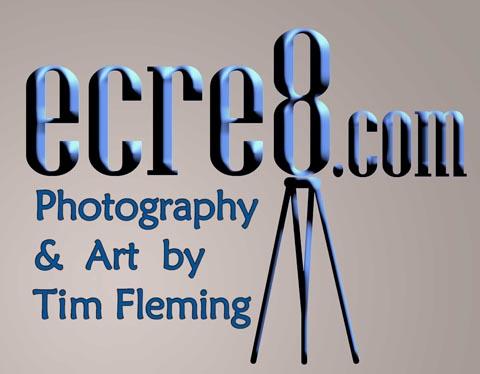ecre8
Pronounced "E-create" ; a word that I invented to describe my processes of using cameras and computers as tools to create images and art. I use any and all digital processes to invent and cre8 images. Ecre8.com is my venue for showing the world my art and craft. Click on the buttons below to explore my images. Once you are in a gallery, just click an image to start the slide show.
Tim A. Fleming, Photographer / Artist
-
Clovis, California

Infrared photography:
The same 4x5 camera that I use to photograph paintings for the Giclee printing process (called a Betterlight Scanning Back) turns out to be extremely sensitive to Infrared wavelengths. It was an obvious choice, all I had to buy was a filter and I was ready to go. When I began shooting infrared it became immediately obvious, if I wanted to create beautiful images, I needed to learn to see in infrared. I think that in order to create good images, you need to be able to previsualize what the final image is going to look like on paper, then take good notes and aim for the original concept.
. The general IR effects include: Blue sky becomes very dark to black, reflections in water become black, most fabrics photograph white or very light gray, people have milky white skin, green leaves and foliage become white, and the tone qualities of other objects also change, some a little and some a lot. IR photography cuts through haze, making distant objects seem closer and sharper. Sometimes the image looks like it is half negative 1/4 normal and 1/4 solarized. I like to photograph familiar subjects in IR, presenting them in a new way. When I imagine the image composed in IR tonalities, my composition changes to fit a new strange universe of IR light. New elements are dominant. That other-worldly tonality is always there but is not always obvious that it was created with the IR process. Sometimes it just looks weird (I like weird). There is a certain amount of shock value to infrared photos. The more familiar the scene type is, the more shock value it seems to have. You’ve got to wrap your brain around the fact that familiar objects and shapes are as expected but some of the tonalities are bizarre and other-worldly, hence it has, what I call shock value. This makes showing my IR images more enjoyable, as people of all levels of artistic education, seem to spend a lot more time looking at my IR images. I like to think that I am challenging people to see familiar subjects in a new and interesting way.”






